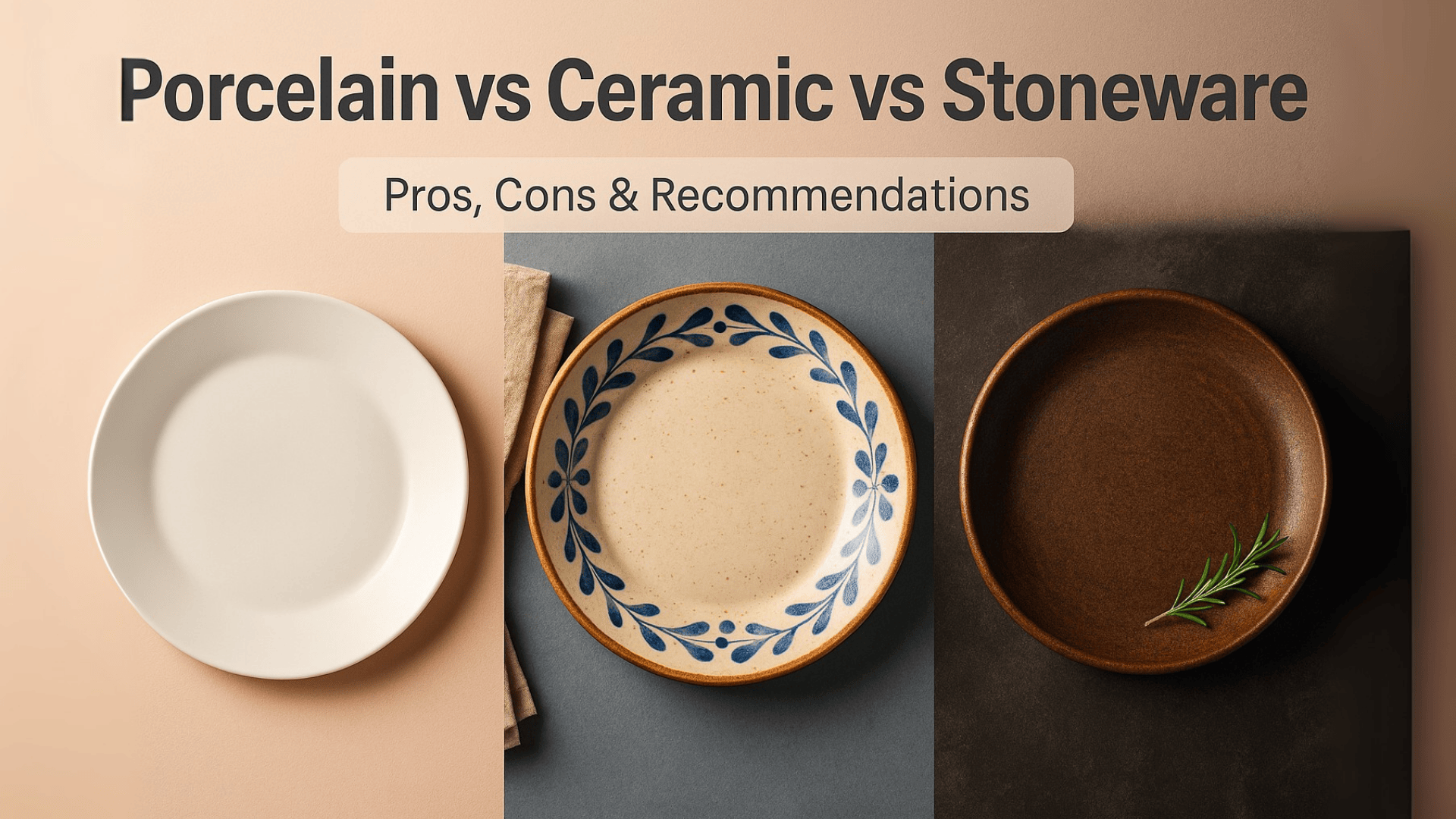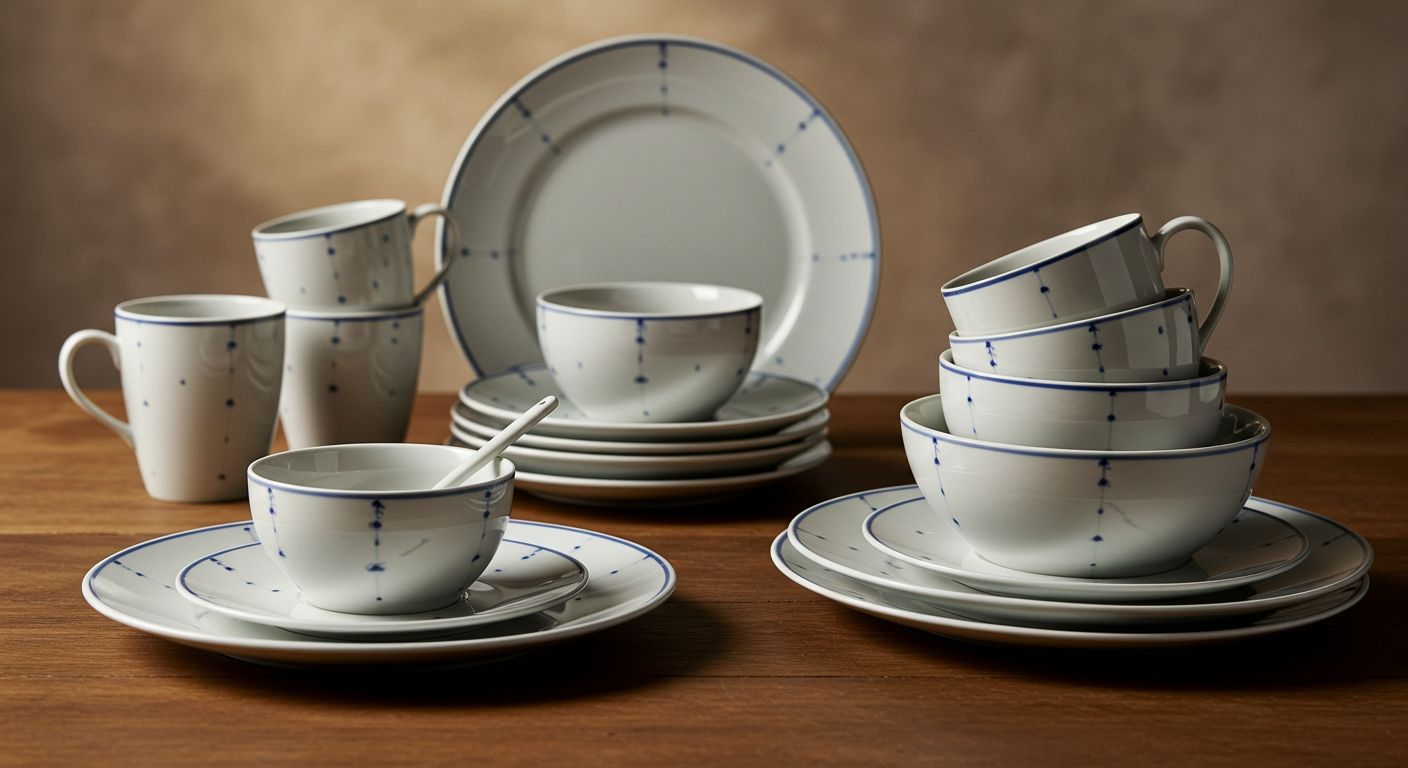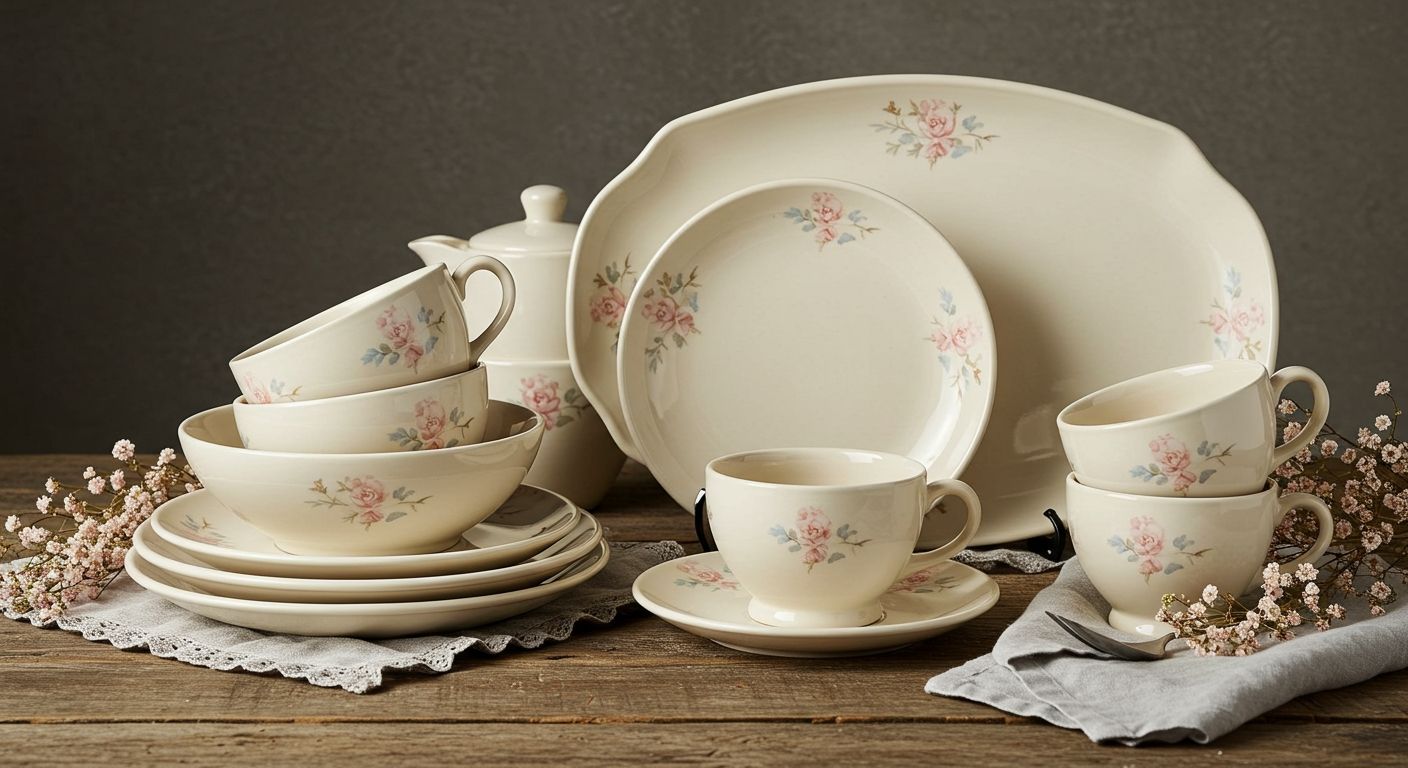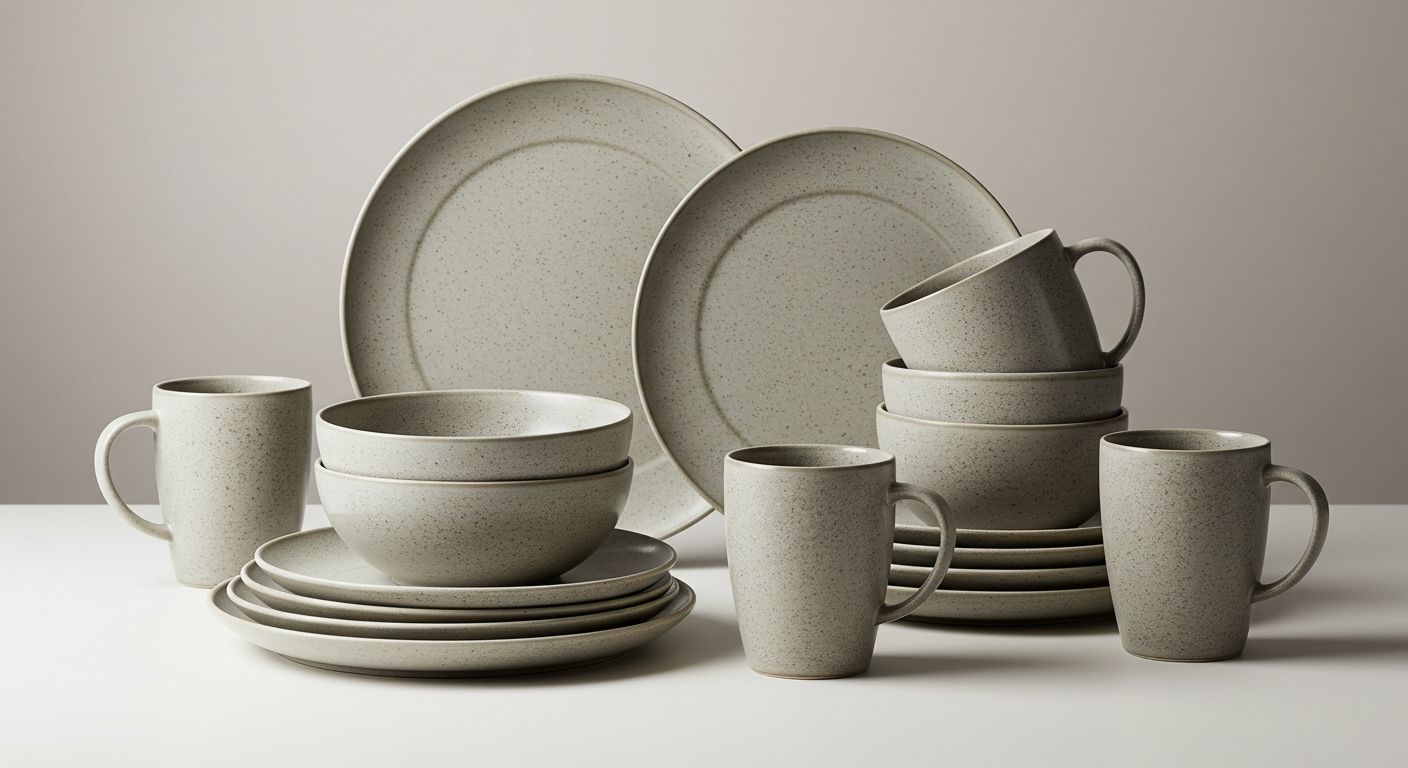
Selecting the best dinnerware material is no less than a headache. Many households make mistakes in their dinnerware selection, which often leads to regret later. If you don’t want to make the same mistake, here is a guide that will help you compare porcelain vs ceramic vs stoneware dinnerware. Many mistakes will be easier to avoid because this guide will help you analyze more effectively. From surface quality to price, all the relevant factors are outlined in this guide.
When we talk about porcelain, everyone imagines an upscale material for dinnerware. It is true because it is made from refined white clay known as kaolin. Additionally, some minerals are used in the heating process inside the kiln to produce the finest grade of ceramic, known as porcelain. A kiln operator must heat it to very high temperatures, between 1260 and 1450 degrees Celsius. It features a glass-like smooth surface and a non-porous finish. Therefore, the value of porcelain is higher than that of other types of ceramics. Many people often ask Is porcelain dinnerware safe? Well, it is secure since it is a non-porous material, along with no leaching at all. People use it on special occasions due to its value and elegant quality.

It is the main category, with subcategories including porcelain, earthenware, and stoneware. Almost every household has a dinner set of ceramic, which shows its safe usage and affordability. Although it has a glazed surface, elegant looks, and an affordable price, it is less durable. Users experience chipping in ceramic more than any other subcategory.

It is the third one, which is a subcategory of ceramic. What makes it unique is its appearance, which is like natural clay. Its production method in the kiln requires around 1175 to 1280 degrees centigrade temperature for the finest results. Then a non-porous, dense, and slightly heavier dinnerware comes in the form. This is what makes stoneware unique, and even its price is affordable. Moreover, it is less prone to chipping than ceramic. You will find that its weight is heavier than the other two types.

Let's do the comparison, which will make your decision easier. We select specific parameters to make it easier to understand. You will need to consider factors such as appearance, heat resistance, durability, safety, and cost to determine what suits you best.
In terms of visual appeal, porcelain beats all. It is because of its elegant and slightly luminous surface. Therefore, its upscale appearance makes it suitable for special occasions. High-end restaurants and hotels tend to use it more when creating a stronger impression on customers. However, the other two are also excellent choices if you are looking for a less expensive option.
Porcelain is superior to the two in terms of durability and strength. It has the highest chip resistance compared to others. Although stoneware has a higher density and earthy appearance, which makes some people choose it. Its strength is comparable to that of porcelain, and its cost is even lower. Both porcelain and stoneware are excellent options if you are seeking durability, strength, and a smooth surface.
When it comes to microwaves and ovens, porcelain is the best choice for durability and performance. The crack resistance against extreme heat is higher in it. If you're looking for a more budget-friendly option with slightly less strength than porcelain, stoneware is a good choice. Ensure there is no sudden change in temperature, as a sudden temperature increase could damage it.
Again, porcelain performs the best in a dishwasher as compared to the other two types. Its strength makes it the safest type. However, stoneware is also a suitable choice if you prefer a slightly heavier and more affordable option.
Stoneware has the best heat retention since it is a heavier and denser type. It allows the dishes to remain hot for longer. Then came porcelain and ceramic. Many commercial and domestic users prefer stoneware for higher heat retention.
Porcelain is usually more expensive than other types. Then came stoneware and ceramic. If you have no worries regarding the budget, you can go for the best type, which is porcelain. If you want a medium way, stoneware will be for you. If you're looking for a budget-friendly solution for regular food presentation, ceramic is the best option.
In summary, porcelain wins the race. It is due to its benefits in terms of visual appeal, strength, durability, heat resistance, and non-porous surface. The only con is its high cost. Otherwise, ceramic is the most budget-friendly option with satisfactory surface quality and strength - perfect if you're looking to explore affordable ceramic dinnerware sets.
If you're looking for regular use with mild quality and a low price, ceramic dinnerware is right for you. For both regular and special occasions, stoneware is a good choice, offering strength and beauty at a decent price. If it is for special occasions with superlative quality and a higher price, porcelain will be the only option for you.
• Read the label of dinnerware before placing it in the dishwasher.
• Avoid using harsh detergents, as they may damage the surface of your dinnerware.
• Stack them carefully, as ceramics may chip quickly, and even other types might start chipping upon frequent mistreatment.
• Read the label also for oven and microwave heat limits, because a sudden temperature change may damage the dinnerware.
• Ensure that you don’t place cold dinnerware on a hot surface or vice versa, as a sudden temperature change could damage the dinnerware.
• Place paddings between dinnerware to prevent chipping.
• Avoid using cracked dinnerware because its cracks are contaminated, which could cause health problems.
A: Stoneware is thicker with a rustic appearance, making it suitable for everyday use. Porcelain is fired at higher temperatures, resulting in a thinner, smoother, and more refined product, often preferred for formal dining.
A: The choice depends on your needs. Porcelain is harder, more refined, and less prone to scratches. Stoneware is heavier, sturdier, and less likely to break if dropped. Stoneware is ideal for daily use, while porcelain offers a more elegant appearance.
A: Yes, porcelain plates are generally considered superior to standard ceramic. Porcelain is stronger, less porous, and more resistant to water, stains, and scratches, which contributes to its longer lifespan.
A: Porcelain is harder and less porous, making it more resistant to scratches and chips. Stoneware’s thickness provides better protection against drops or impacts. Both materials are durable, each with distinct advantages.
A: Stoneware is a type of ceramic fired at higher temperatures, making it denser and stronger than standard earthenware. It is typically preferred for everyday use due to its durability.
A: Porcelain is stronger in terms of density and scratch resistance, while stoneware’s thickness provides better impact resistance. Each material offers advantages depending on the intended use.
It all depends on your purpose, dining setting, and budget when selecting dinnerware. Ceramic, porcelain, and stoneware are all suitable choices under their respective conditions. For regular use, ceramic is appropriate, while for formal or special events, porcelain is preferable. If you want to use one type for both, stoneware will be a decent choice.
Choosing the preferred bowl to take your meals might sound easy, yet this real
READ FULLSelecting the best dinnerware material is no less than a headache. Many households make mistakes
READ FULL